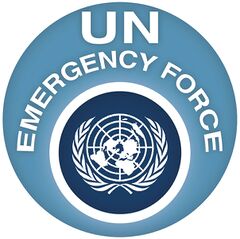UNEF I
(UN blue helmets) | |
|---|---|
 | |
The United Nations Emergency Force (UNEF I) was a military and peacekeeping operation established by the United Nations General Assembly to secure an end to the Suez Crisis of 1956 through the establishment of international peacekeepers on the border between Egypt and Israel. Approved by UNSC Resolution 1001 (ES-I) of 7 November 1956, UNEF I was developed in large measure as a result of efforts by UN Secretary-General Dag Hammarskjöld and a proposal from Canadian Minister of External Affairs Lester B. Pearson, who would later win the Nobel Peace Prize for it. The UN General Assembly had approved a plan submitted by the Secretary-General which envisaged the deployment of UNEF I on both sides of the armistice line; Egypt accepted receiving the UN forces, but Israel refused it.
In May 1967, Egypt asked that UNEF I leave Egypt;[1] as the troops started to evacuate over the next days, Israel invaded Egypt on 6 June 1967, initiating the Six-Day War and causing the death of one Brazilian Sergeant and 14 Indian peacekeepers – 17 other members of UNEF were also injured. The last member of UNEF I left Egypt on 17 June 1967.
The UN General Assembly later established a Second United Nations Emergency Force (UNEF II) in 1973 in response to the Yom Kippur War.[2]
References=
Wikipedia is not affiliated with Wikispooks. Original page source here